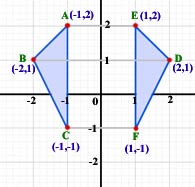What type of reflection is this?

A reflection across the y-axis.

A translation is a function that maps each point to its image along a vector, called the translation vector, such that each segment joining a point and its image has the same ______ as the vector, and is also ______ to the vector.
A translation is a function that maps each point to its image along a vector, called the translation vector, such that each segment joining a point and its image has the same length as the vector, and is also parallel to the vector.
If a direction is not given for the type of rotation, is it always assumed to be rotating clockwise or counterclockwise?
What type of rotation is not different if you spin clockwise or counterclockwise?
If a direction is not given for the type of rotation, is it always assumed to be rotating counterclockwise.
Rotating 180 degrees does not change upon spinning clockwise or counterclockwise.
What are the image points of parallelogram QRST with vertices Q(-1, 4), R(4, 4), S(3, 1), T(-2, 1) when reflected along the x-axis?
Q(1, -4), R(4, -4), S(3, -1), and T(-2, -1)
What are the image points of a triangle DFG with vertices D(-8, 8), F(-10, 4), and G(-7, 6) translated along <5, -2>
D'(-3, 6), F'(-5, 2), and G'(-2, 4)
What are image points of triangle JKL with vertices J(2, 6), K(5, 2) and L(7, 5) after rotating 90 degrees about the origin?
J' (-6, 2), K'(-2, 5), and L'(-5, 7)
Triangle JKL has vertices J(2, 4), K(0, 0), and L(-4, 2). Graph JKL and its reflection along the line x = -2
J'(-6, 4), K'(-4, 0), L'(0, 2)
Graph quadrilateral FGHJ F(-4, -2), G(-1, -1), H(0, -4), and J(-3, -6) and its translation F'(-7, -4,) G'(-4, -3), H'(-3, -6,), J'(-6, -8)
What is the translation vector? <__,__>
What is the translation vector? <-3,-2>
Triangle DEF has vertices D(-4, 1), E(-2, 4), and F(-2, 1) graph its image after a rotation of 270 degrees clockwise about the point (-3, 2)
D' (-1, -1), E'(1, 2), and F'(1, -1)
D'' (1, -1), E''(-2, 1), and F''(1, 1)
D'''(-4, 3), E'''(-5, 3), F'''(-2, 3)